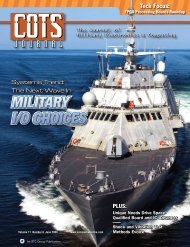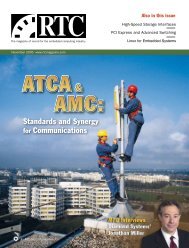Inrush Current Control Technology Boosts Power Converter Reliability
Inrush Current Control Technology Boosts Power Converter Reliability
Inrush Current Control Technology Boosts Power Converter Reliability
Create successful ePaper yourself
Turn your PDF publications into a flip-book with our unique Google optimized e-Paper software.
[ 22 ] COTS Journal November 2011<br />
Untitled-4 1 7/25/11 10:31:05 AM<br />
Special Feature<br />
Figure 2<br />
Large-format Lithium-ion prismatic cells are proving themselves in interesting pilot<br />
programs as they offer up to 70 times the capacity of traditional packaged lithium batteries<br />
that are the size of a D cell.<br />
cost of lead-acid batteries has made them<br />
a popular choice for several years, many<br />
integrators are now turning to advanced<br />
chemistries such as Lithium-ion for more<br />
energy-dense applications. Figure 1 lists<br />
the many advantages Lithium-ion batteries<br />
have over lead-acid batteries.<br />
Finding the Right Fit<br />
Large-format cells, also referred to<br />
as HyperClass Lithium-ion prismatic<br />
cells, (Figure 1) on the market today are<br />
proving themselves in interesting pilot<br />
programs as they offer up to 70 times<br />
the capacity of traditional packaged<br />
lithium batteries that are the size of a D<br />
cell. While most lithium batteries are<br />
produced as small cylindrical cells up to<br />
3 Ah or “pouch” prismatic cells up to 10<br />
Ah, large-format cells can range from 50<br />
Ah to 200 Ah. With each individual cell<br />
being considerably larger, large-format<br />
batteries greatly decrease the number of<br />
cells needed within the battery module,<br />
which improves reliability and efficiency<br />
while lowering maintenance costs and<br />
the number of connectors. Individual cell<br />
monitoring with the use of Battery Management<br />
Systems (BMS) is a key to success<br />
with these systems.<br />
Weight, temperature and energy requirements<br />
are all important factors to<br />
consider when choosing Lithium-ion bat-<br />
teries. Some have very wide temperature<br />
ranges and can be ideal for in-field vehicles<br />
that experience high desert temperatures<br />
and meet longer runtime demands, but<br />
not many have military testing certification,<br />
which is an important requirement.<br />
Lithium iron phosphate chemistry—a<br />
form of Lithium-ion—is by far the safest<br />
and therefore the best choice for power<br />
delivery applications.<br />
Energy Storage: The Silent<br />
Advantage<br />
The Tank Automotive Research,<br />
Development and Engineering Center<br />
(TARDEC), has developed a hybrid energy<br />
storage system suited for tanks and<br />
Stryker armored vehicles. This energy<br />
storage system has been implemented<br />
within the current Silent Watch program,<br />
aimed at allowing military vehicles<br />
to operate with little to no audible<br />
signature. Developing tanks and military<br />
Humvees more suited for covert missions<br />
is a major challenge, and energy storage<br />
plays a huge role in the development of<br />
this program.<br />
The Silent Watch vehicles rely on<br />
the battery system to operate quietly for<br />
stealth and tactical missions (Figure 2).<br />
With the communications systems being<br />
powered by the battery, the audible signature<br />
of these vehicles is greatly reduced






